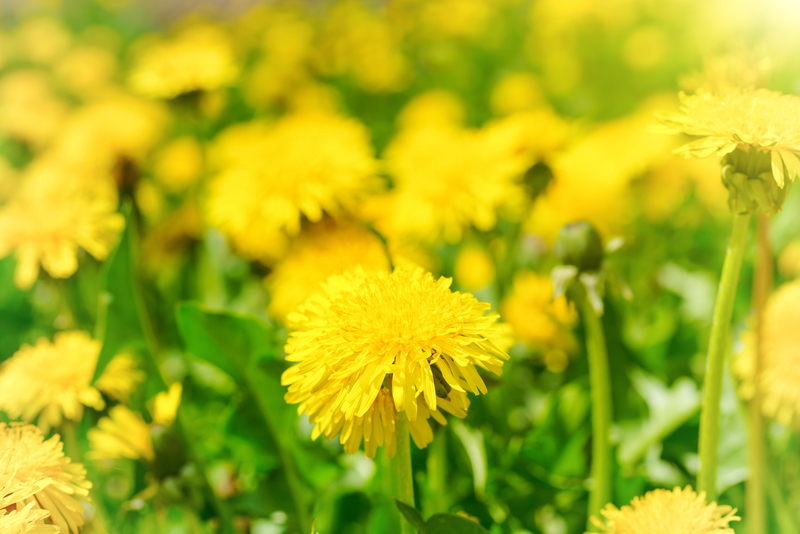Revitalize Your Neglected Green Space Now
Posted on 29/09/2025
Revitalize Your Neglected Green Space Now: Transform Your Outdoor Area into a Lush Oasis
Has your garden become overgrown, patchy, or unruly? Is your backyard more of a forgotten wasteland than a place for relaxation and joy? Now is the perfect time to revitalize your neglected green space! Whether you have a small urban yard, a sprawling suburban garden, or just a simple patch of grass, rejuvenating these areas can add beauty, tranquility, and value to your property. In this comprehensive guide, we'll walk you through practical strategies to restore, enhance, and maintain your outdoor space, ensuring it becomes your favorite spot once again.
Why Revitalize Your Neglected Garden Space?
First, let's answer the burning question: why should you put in the effort to reclaim your outdoor environment? Your green space, whether it's a lawn, flowerbed, or wooded nook, is more than just a plot of land--it's an extension of your home and a sanctuary for both mind and body.
- Boost Curb Appeal and Property Value: A well-kept yard increases your home's value and creates a great impression for visitors and potential buyers.
- Enjoy Health Benefits: Green spaces reduce stress, improve mood, and encourage outdoor activities for you and your family.
- Support Local Wildlife: Revitalizing neglected gardens provides habitats for pollinators, birds, and other beneficial wildlife.
- Promote Eco-Friendliness: A flourishing garden helps with stormwater absorption, cools the landscape, and reduces carbon footprint.
Whether you want a lush lawn, a thriving vegetable patch, or simply a peaceful escape, it all begins with taking action now.

Assessing the Condition of Your Neglected Green Space
Before you can effectively renew your outdoor area, take a close and honest look at its current state. Make a quick inspection checklist:
- Are there large patches of weeds or bare soil?
- How healthy are the existing trees, shrubs, and plants?
- Is the soil compacted or waterlogged?
- Are there signs of pests or plant diseases?
- How much sun and shade does the area receive?
- Are paths, fences, raised beds, or garden structures in good repair?
Make notes, and even take photos for a before-and-after comparison. This assessment serves as your foundation for a clear, actionable revival plan.
Tip: Start Small, Think Big
Tackling the whole garden at once can be overwhelming. Prioritize high-visibility or high-use areas first, and break larger projects into manageable steps.
Step-by-Step Plan to Revitalize Your Neglected Outdoor Area
1. Clear Out Debris and Overgrowth
Begin by removing obvious debris such as fallen branches, litter, dead plants, and old garden furniture. Prune overgrown bushes and trees to open up the space and allow light and air to circulate. Regular tidying is the fastest way to start your green space transformation.
- Rake leaves and twigs into compost piles.
- Prune dead or diseased wood from shrubs and trees.
- Pull out invasive weeds by the roots to prevent regrowth.
2. Restore the Soil for Vibrant Growth
Healthy soil is the foundation of any thriving green space. Test your soil's pH and nutrient levels using a basic home kit or professional service.
- Amend depleted soil with organic matter like compost, manure, or leaf mold to restore fertility and improve structure.
- Aerate compacted lawns with a garden fork or aerator to allow roots and water to penetrate.
- Mulch garden beds to retain moisture, regulate temperature, and suppress weeds.
Tip: For areas with poor drainage, consider installing a French drain or raised beds.
3. Rejuvenate Lawns and Grassy Areas
Is your grass patchy, yellowed, or overtaken by moss? Don't despair! With the right approach, you can revive your neglected lawn and get lush, green results:
- Rake away dead grass (thatch) to promote airflow.
- Sow grass seed in bare areas and water regularly until established.
- Fertilize in spring and fall with a balanced lawn feed.
- Mow regularly, but never remove more than a third of the grass blade at once to prevent shock.
If you prefer a more ecological approach, consider replacing traditional lawns with native grasses or wildflower meadows for a low-maintenance and pollinator-friendly solution.
4. Refresh and Replant Flower Beds
Bring your flowerbeds back to life by clearing weeds, enriching soil, and adding new plants.
- Choose low-maintenance perennials such as daylilies, hostas, or echinacea for lasting blooms.
- Mix in annuals for seasonal color and visual interest.
- Divide and replant overcrowded perennials to encourage healthy growth and fill in gaps.
- Group plants by height, color, or bloom time to create year-round appeal.
Create layers of texture and color to transform your once-neglected planting beds into a garden you'll be proud of.
5. Revive Walkways, Patios, and Garden Features
Hardscape areas often suffer from neglect. Power-wash pathways, patios, and decking to remove moss and dirt. Repair broken stones, trim encroaching grass, and consider adding edging to keep everything tidy.
- Add solar lighting for ambiance and safety in the evenings.
- Paint or stain fences and sheds to refresh their look.
- Incorporate new focal points like a birdbath, garden bench, or water feature for added charm.
6. Introduce Edibles and Native Plants
For both sustainability and pleasure, integrate edible plants and native species into your green space. These plants are more resilient, require less water, and support local wildlife.
- Start a herb spiral or raised vegetable bed in a sunny spot.
- Add fruit-bearing bushes (like blueberries or raspberries) that offer beauty and a tasty harvest.
- Choose native flowers and shrubs for pollinator gardens--these need less maintenance and are more likely to thrive.
7. Mulch, Water, and Maintain
Sustainable renovation means ongoing care. Once you've tackled the big jobs, set a simple maintenance schedule:
- Mulch regularly: Refresh mulch each season to control weeds and protect roots.
- Water wisely: Early morning or evening watering reduces evaporation. Consider using a rain barrel to collect free water.
- Monitor for pests and diseases, treating with eco-friendly methods like neem oil or companion planting where possible.
Staying on top of minor tasks prevents your revitalized lawn or garden from slipping back into neglect.
Creative Ideas to Personalize Your Revitalized Green Space
Beyond just planting and cleaning, your revived outdoor area can reflect your unique style and interests! Consider these inspiring enhancements:
- Outdoor Rooms: Arrange furniture for a reading nook, yoga zone, or family dining spot.
- Themed Gardens: Try a butterfly garden, rock garden, or sensory garden with fragrant and textured plants.
- DIY Features: Build a compost bin, birdhouse, or vertical garden with repurposed materials.
- Children's Play Area: Add a swing, sandbox, or raised playhouse for family fun.
- Secret Corners: Tuck a hammock or fire pit into a secluded area for relaxation or entertaining.
Remember: Your green space is yours to shape and enjoy--let your imagination run wild!
Eco-Friendly Tips for Sustainable Green Space Recovery
Eco-conscious gardening not only preserves the environment but also yields a healthier, lower-maintenance landscape.
- Compost your garden waste to return nutrients to the soil naturally.
- Select native species that thrive in local conditions and require less water and fewer chemicals.
- Use organic fertilizers and natural mulch to enhance soil without harming wildlife.
- Minimize artificial pesticides by encouraging beneficial insects and using physical barriers or traps where necessary.
- Install rain gardens or permeable paving to reduce runoff and support groundwater replenishment.
Every small step towards sustainability helps you revitalize your outdoor environment while protecting the greater ecosystem.
Common Mistakes to Avoid When Revamping Your Garden
Eager to revitalize your neglected green space now? Avoid these typical pitfalls:
- Doing too much at once: Spread projects out to stay motivated and avoid burnout.
- Underestimating soil health: Healthy plants start with healthy soil--never skip this step!
- Overwatering or underwatering: Research the requirements of your chosen plants.
- Ignoring shade and sun patterns: Match each plant to the right microclimate for best results.
- Planting too closely: Leave enough space for plants to reach their mature size.
- Neglecting regular upkeep: Even a few minutes each week keeps chaos at bay.
Seasonal Advice to Keep Your Outdoor Space Thriving
The key to a long-lasting, beautiful green space is year-round care. Here's a seasonal checklist to help you maintain your newly revitalized area:
Spring: Time for Growth
- Prune winter damage, aerate lawns, and refresh mulch.
- Start seeds indoors and transplant young plants after last frost.
- Fertilize and repair garden features as needed.
Summer: Water and Protect
- Water deeply and regularly in dry spells.
- Deadhead flowers to encourage continuous blooms.
- Keep weeds in check and watch for pests.
Autumn: Prepare for Rest
- Plant bulbs for spring color.
- Compost fallen leaves and clear spent plants.
- Protect tender plants from early frost.
Winter: Plan Ahead
- Review successes and challenges from the past year.
- Clean and sharpen tools; organize shed or storage.
- Plan next year's bedding, order seeds, and dream up new projects!

Frequently Asked Questions About Green Space Revitalization
How long does it take to restore a neglected green space?
With sustained effort, significant improvement can often be seen within a few weeks, especially in terms of tidiness and initial plant growth. Complete transformations vary based on size, plant types, and condition, so be patient and consistent for best results.
Do I need professional help to revitalize my outdoor area?
Many simple tasks--clearing, pruning, planting, and mulching--can be tackled by any motivated beginner. Larger projects (like tree removal, hardscaping, or persistent pest problems) might require specialist assistance.
What's the best time of year to start my garden restoration?
Spring and early fall are ideal, offering mild temperatures and optimal growing conditions, but any season can be suitable with the right adjustments and plant choices.
Start Today: Revitalize Your Neglected Green Space Now!
There's no better time than now to reclaim, restore, and enjoy your neglected green space. With planning, a little elbow grease, and ongoing care, even the most forgotten outdoor area can become a vibrant retreat.
- Start with small projects you can complete in a single afternoon.
- Invest in the health of your soil and plants for lasting beauty.
- Regularly maintain your space to protect your hard work.
- Embrace creativity and sustainability throughout your transformation journey.
Commit to revitalizing your green space now, and you'll create a flourishing outdoor paradise that rewards you every season for years to come!

